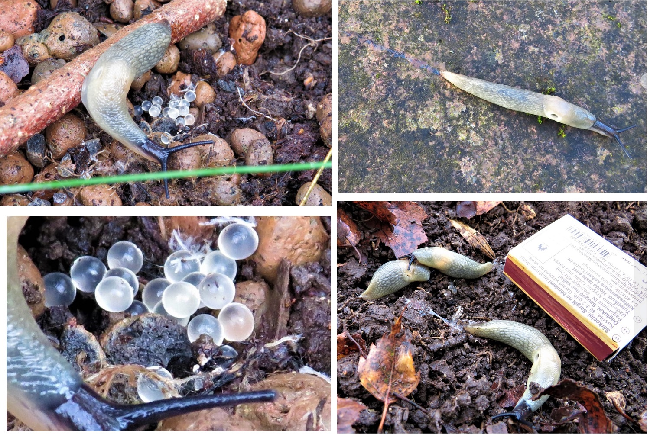Picture: Ene Grass (Teokaart)
Even though the autumn weather is a little cooler, it's not yet time to stop controlling invasive insects such as the Spanish tea weevil and the blackfly. The starving animals will continue to be active in autumn until the weather turns cold.
In mild and humid weather, the hungry can lay eggs until late autumn. The Spanish snail lays eggs in small clusters, for example under a layer of crumbs, in a pile of leaves or compost, or under the edge of a greenhouse. The black woodpecker lays its eggs under leaves, in leaf piles, but also in the surface layer of the soil.
As the weather gets colder, the hungry will seek sheltered hibernation sites protected from the cold: for example, compost heaps, leaf and twig piles, earthworm holes or various cracks in the ground, the edges of buildings.
The earlier the snow falls, the deeper and softer the winter, and the longer the snow cover stays on the ground, the better the conditions for invasive species to survive the winter. Both species can also tolerate slight frosts (down to -2 degrees). It is the young specimens and the eggs that are better able to withstand cold. The adults that have laid eggs usually die at the end of the season.
Recommendations for autumn activities:
- Continue to harvest and kill both Spanish teasels and black-eyed peas. Kill the collected specimens by 'quick killing', for example by cutting the hungry in half or by pouring boiling water on the collected hungry.
- Bury the dead hungry at shovel depth or follow the advice of the municipality. Also, if you put them in a special container, make sure that all the specimens are dead!
- Be sure to pick up any clumps of snails' eggs and pour boiling water over them, or break them. You can recognise the eggs by their whitish, glassy transparency. Proceed as with the dead specimens.
- Rodents look for a moist place to lay eggs and hide: keep bush and shrub beds, various railings, walls well-maintained; trim shallowly moulded perennial beds; if there is a compost heap, dig it out; periodically check flower pots, plant containers, various bases.
- Attracting wild enemies to the garden can help - various birds, beetles, hedgehogs, ducks - all can eat the eggs and young of foreign predators.
- Under no circumstances should leaves, apples, cuttings and other garden waste be taken into the wild, as this would spread the parasites! Compost garden waste in your own garden or use the solutions provided by your local authority, including bio-waste containers.
- You can build dry or sharp shelterbelts of sand, gravel, eggshells, coffee grounds, sawdust, ash around the fences - hungry people don't want to move on such ground. The effect may be short-lived, so they should be renewed.
- When you bring new plants home, check them carefully, plant them in a deep soil ball and compact with soil, and if possible keep the plant pot in a transparent plastic bag for several weeks in quarantine.
- If your garden is infested, don't share your garden plants or compost and clean your tools and equipment regularly.
- Make sure you communicate with your neighbours so they also keep out intruders.
We can also spread starvation by completely accidental means such as vehicles and other machinery, firewood - anything that starving animals or their eggs can attach themselves to. So - whenever you find even a single hungry alien, big or small, you must quickly exterminate it!
Report the discovery of an alien stowaway using the teocard: teokaart.keskkonnaamet.ee
Find out how to recognise alien invasive species on the website of the Environment Agency: Alien predators | Environment Agency

